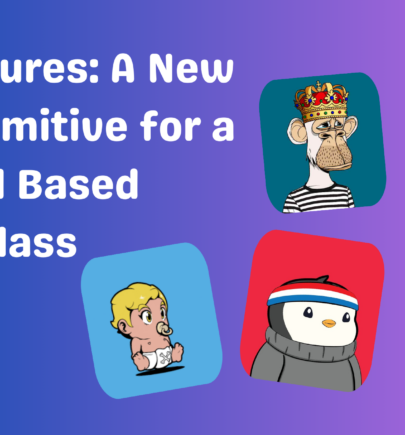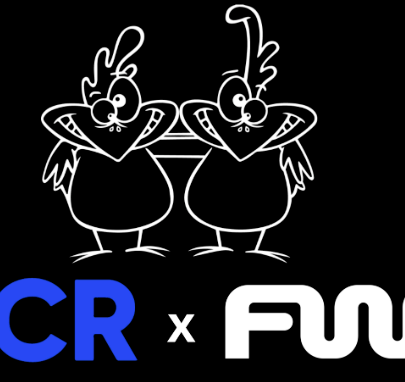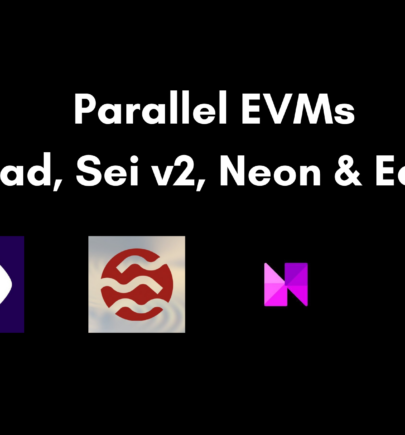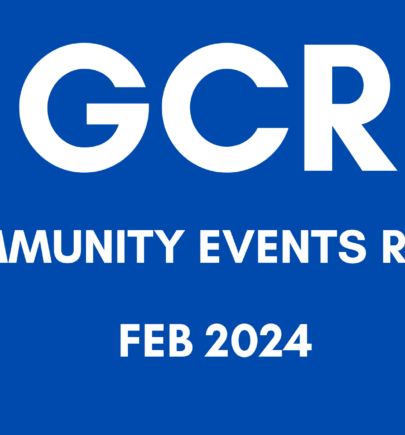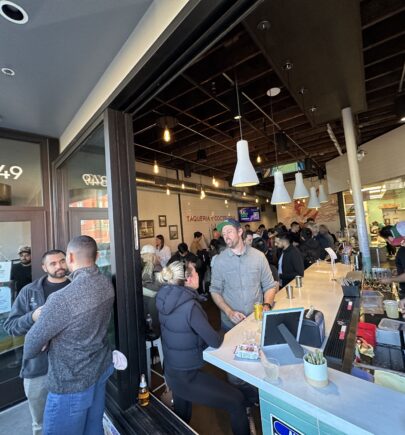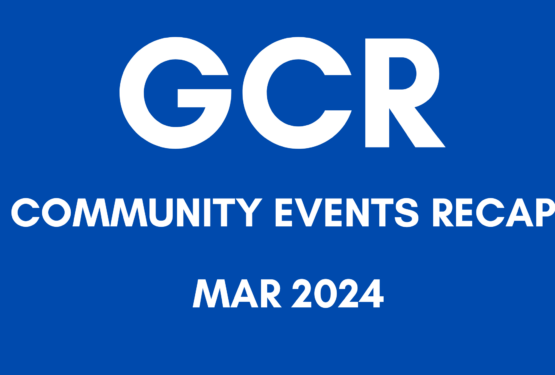Managing A Web3 Community

A Guide For Community Builders!
Before diving into the specifics of managing a web3 community, we need to be clear with the definition of web3, i.e., what exactly is web3? What are the principles that govern the communities under web3?
Interesting questions indeed, just like the vision of Web 3.0!

Definition and Underlying Principles
Web 3.0 is something that’s envisioned as the new era of internet, governed by protocols and platforms that are highly decentralized.
Decentralization in a context where there are no centralized bodies that would be required for users to go through. The power is in the hands of people, not a single entity.
There are various types of decentralized platforms that exist like DAOs (Decentralized Autonomous Organizations) and DeFi (Decentralized Finance) platforms.
DAOs are very interesting: based on the core principle of decentralization, there’s no single governing entity but rather the members of the DAO steer the way! (DAOs function through smart contracts, which could be deployed on several blockchain networks accordingly. Members who stake in the particular DAO possess certain voting rights on governance plans.)
Decentralized finance challenges the idea of traditional banking: revolving around the idea of decentralization, everything is in the hands of the user(s), not an entity on which a certain amount of trust has to be put in with funds.
The most important principle and takeaway from these visions are that transparency is very important. Transparency among the community is what makes Web3 better than the traditional Web2. Managing a Web3 community requires one to have a fundamental understanding of the mindset of people that are actively participating.
Not just transparency, members need to:
- Trust in the idea of the community
- Actively take part in discussions
- Pitch in suggestions
- Be a part of governance proposals
- Help onboard new members
- Promote the community
- Maintain a relevant environment
All these need to be regulated and managed accordingly. You won’t just randomly get active members that will devote their time to the community, they have to be cultivated. One has to engage people and transition them from random internet web3 enthusiasts into participating community members.
The transition is an extremely tough one to make, and only the communities that manage to successfully do this can themselves be a success because it all depends on the community and the people in it.
To do exactly that, a community has to be managed in a way that there is maximum interaction between its members.
And how is that possible? To answer that question, one has to have the right set of questions first.
- What are the ways to make people trust the idea of the community, be it an NFT project, a DAO, or a DeFi platform, so that people actually devote their time and money to it?
- What should the team do to continuously engage the members?
- What are the ways to promote and spread the word of the community?
- What are the event ideas for the community?
- How to induct more people to the idea and make inexperienced peeps on the internet understand the concept behind the community?
With these few questions getting us started about how to manage a community, we now have the basic structure needed to help us start building the community.
Firstly, we need people to understand the idea and vision behind the community and enforce it through certain ways that would make them believe in it.
The ways to go about it would be:
1) Get a YouTube video made about the idea, vision, and principles on which the project/protocol/platform is built, in an artistic way that will engage the audience. The higher the engagement numbers, the higher the conversion (from random internet people to community members)! Here’s an example video from a DAO called Olympus using a YouTube video to put across their idea (simple, clean, and efficient way of explanation):
https://youtu.be/QZOaZ9dd-ms
2) Take the help of Infographics to explain simple differences/principles of the community platform. 2) Create and employ infographics to explain simple differences/principles of the community platform. Infographics could be fun-themed. Here’s a great example from Notional Finance:

3) Have an active Discord server that would enable members to interact with each other, Discord is considered the most effective medium of communication and the most important for Web3 Communities.
> A Discord server is the backbone of communities on the internet and having a very neatly managed Discord is sometimes what makes a difference.
> So what goes into the secret sauce of having a neatly managed Discord server? We need to understand that Discord has a lot of functionalities that could be used to benefit user interactions and to host a lot of interesting stuff.
> To make maximum use of Discord, one has to arrange it in a way that the user has the utmost edge and ease of interacting with the community.
> Channels are an integral part of managing a Discord server, and having the right channels assigned to the right parts of work/use helps the members distinguish accordingly.
Here’s an example of GCR’s Discord server:

Here we can see that it’s divided very specifically and according to topics, so the users have a good time having different types of conversations and interactions based on their interests and levels of involvement, which is a very important part of community building.
The organization of the information is extremely important in a community that has a lot of technical jargon, as well as other core community-related principles, and these text channels help them organize and make it easier for members to go through and also refer to, whenever needed.
People can have fun, chat, discuss serious stuff, meme about, have late-night conversations about the community/blockchain, or anything under the sun in the voice channels, so voice channels are also very important to have.
While having specific Discord channels helps, there’s also an equally important aspect of having Discord roles.
A community could be an NFT project, a DAO, or a unique protocol based on blockchain, but there are always people with diversified skill sets in a community; dividing them under Discord roles only helps in managing a community and helping the members know each other based on their skills, which again adds to the building block of a community.
Roles could be quirky titles given to people with unique talents (example: memelord) or could just very well be their skill (example: writer, videographer, developer).
Roles can depend solely on the idea of the community: a fun community could experiment very creatively with roles, have specific tasks assigned to the roles and make everything more engaging through an ecosystem of roles working mutually.
More importantly though, the internet is a very interesting place and sometimes people get too salty over things or might break community rules, so a structured moderation team should also be in place.
The moderation team should be assigned in such a way that there’s always someone from the moderation team online in Discord to maintain the decorum and environment of the community. Otherwise, one person can spoil the community experience for a lot of people and that’s a HUGE RED FLAG to a lot of people. People join communities that are friendly, accepting, and well-run, and the moderation team has to maintain that environment.
The breakdown of the moderation could be as follows:
Chat Moderators: solely moderate the community channels and look for people that violate chat rules in channels or who insult/disgust/write stupid things.
Voice Moderators: moderate the decorum of voice channels and make sure that people don’t swear or spoil the experience for others.
Managing Moderators: they can supervise the following moderators and keep a track of the daily happenings of the server.
Helpers: these guys can help out people with queries, doubts, and everything community-related as quickly as possible.
Admins: management team, community managers with all powers on Discord.
A similar structure should be followed in order to make sure that the community doesn’t face any sort of violations by users who are not interested in interacting.
A community only grows when users feel like they’re being treated according to their own liking. To provide such an experience, there has to be constant interaction from the community team to the users while also making the community self-independent, and once this cycle is created, more and more users become MEMBERS!
DISCORD BOTS: THIS IS AN EXTREMELY IMPORTANT PART! DISCORD BOTS HAVE A LOT OF USE CASES AND ACTUALLY HELP A LOT IN COMMUNITY BUILDING.
There are a lot of useful functions that can be accomplished through Discord bots, such as employing welcoming bots, faucet bots, verification bots, etc. All of them have specific purposes and they make life on Discord so much easier.
A community must have the necessary Discord bots but apart from that, there are a lot of innovative approaches to this particular field. Many communities make custom bots to specifically fit the ideas of their communities into the bots.
One such example would be the gmBOT by Layer3. Users vibe in the Discord and members — as a community ritual — type “gm” (good morning) every day in that specific text channel, thus making it highly interactive, and even adding features like a leader board:
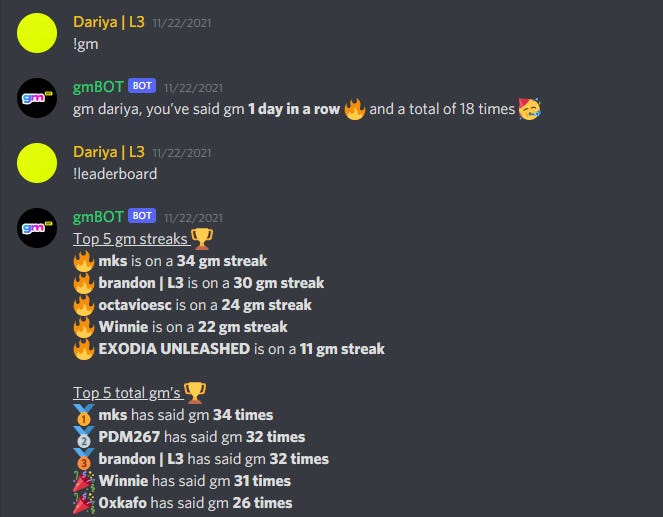
Another example would be tip.cc bot. This bot is extensively used for the purpose of gifting cryptocurrency to each other on Discord, a very unique concept that enables users to reward each other whenever someone helps each other, to like someone’s work, or just wants to plainly gift each other some crypto!
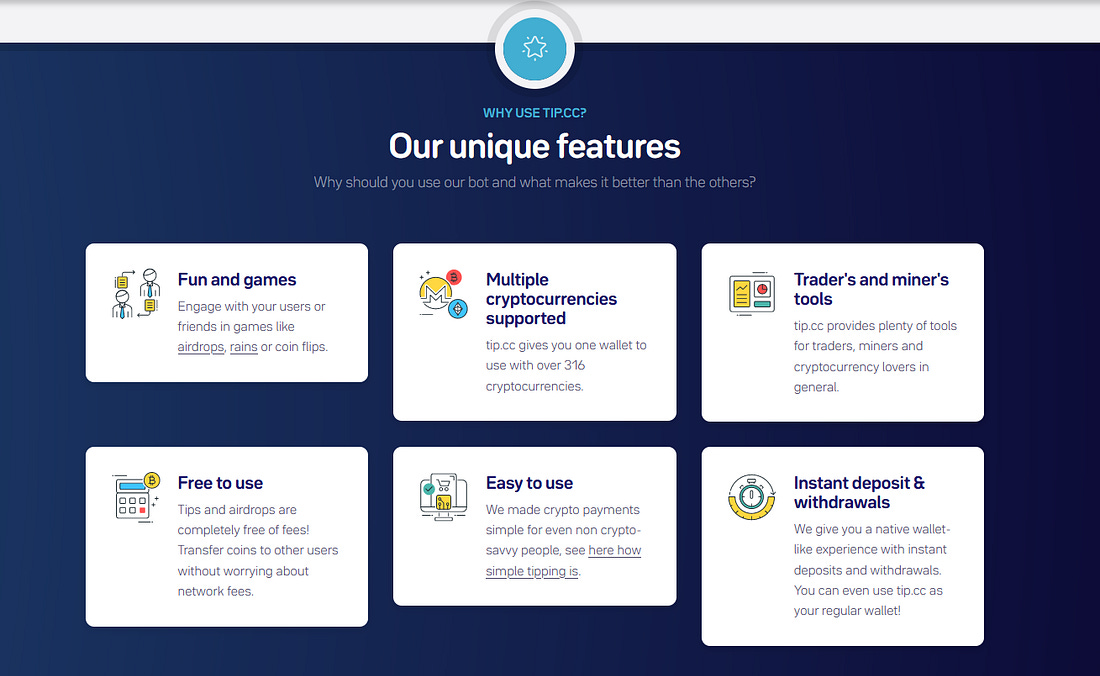
Small things like these sometimes make huge differences in community building.
> Have extremely active social media accounts which the members can follow for events, news, and information regarding the community.
Twitter is the most used social media in the web3 space due to the way it is designed, enabling community members to interact with each other through likes, retweets, and tweets!
It is extremely important to run various campaigns and fun activities on Twitter as well to deliver content related to the community in a way that users like to consume.
Talking about Twitter, I’m including a tweet here that tells us that “In Web 3.0, Member Experience (MX) is as important as the User Experience (UX).” This is a thread of important questions that builders will want to ask and answer, and is very worth reading:
People on the internet don’t like content that is straightforward and mundane, so it is extremely necessary to make it appealing and have that element of excitement. Twitter can help enable this aspect.
Presentation is everything on the internet and “hype creation” can be considered a very important aspect in this space. Considering the attention span of people on social media networks, one has to grab attention in order to engage.
Here’s an example of “hype creation” from GCR’s Discord server:

Brainstorming is needed to catch up with the latest trends on the internet and make use of that to create hype about the community, Twitter could prove very useful in this. One such example of that would be a tweet made by @Layer3, making use of the latest hype of #SpotifyWrapped to engage their community members:

Newsletters and blogs are also considered very important in community building. A community with regular newsletters every week and a blog to educate its members on new upcoming events and updates are extremely crucial to keep the engagement ratio high!
Blogs can be used to educate new members that have little experience with blockchain-related concepts or who don’t know the underlying principles of the community. Your blog can easily be used to explain to such people in simple language about the working and specifics of the community. It could be a Medium (pun intended) of extreme productiveness in the community.
Not just blogs and newsletters, a podcast could also be a very interesting addition to a community, as a lot of people actually like to listen rather than read — that’s where the podcast comes into place. A lot of communities use podcasts to spread knowledge and have discussions around the idea of their community, blockchain, or tech in general.
One such example would be the Superteam Podcast on YouTube.
> Events!
A community always requires events to complement the growth of its members; sometimes it can be the anniversary of the community itself, a specific day of celebration, or just something that all the members come up with together. Events should be an integral part of the community.
NFT party? Random Meme Competition?
Writing competition?
Lottery?
Bounties?
Events that make members excited are the ones that keep them in the community; events also help in spreading the word about the community. Everyone wants to be a part of fun events, right?
Example from GCR’s Discord:

> Rewards!
People love to earn something in return for their work, don’t they? Rewards are always appreciated by people and make them devote more of their time to the community. Incentives also incentivize participation.
A community, for example, a DAO, can use a lot of tools to reward its members in a way that they feel is fair. Some communities have fairly simple bounties whereas some use platforms like Coordinape or SourceCred to reward their contributing members.
Some communities also amend the rewarding system according to their needs and give out rewards accordingly.
Simple graphics are always appreciated that explain complex community structures to new people. A community should always make sure that it’s friendly for new members, tech veterans, and people in the middle. That’s how a community in web3 should be, accepting and inclusive of everyone!
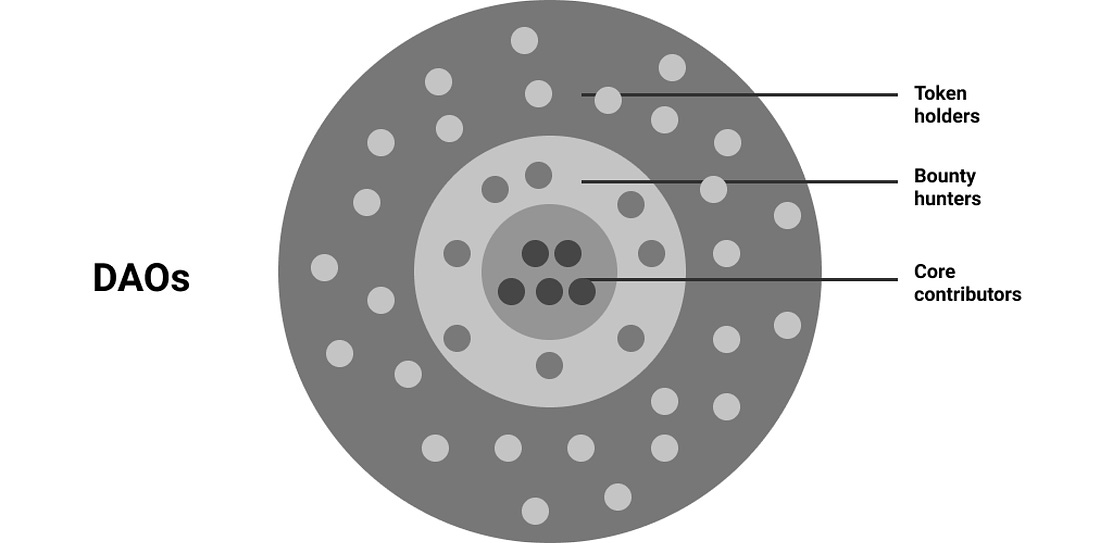
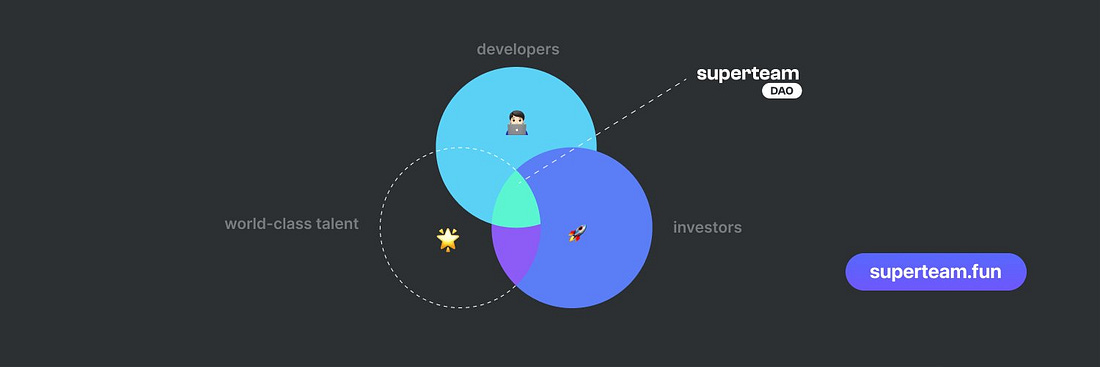
These simple graphics explain the most complicated structures in such clean detail, making people on the internet more intrigued by the concept of a certain community!
A community is all about the people in it and as long as they stay and help it grow, nothing can grow wrong. A community builder has to find people that believe in the community, belief is a very strong currency of the world!
Good luck builders!

